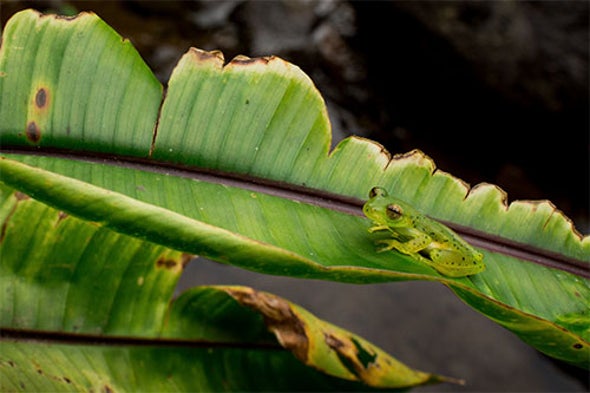(单词翻译:单击)
听力文本
This is Scientific American's 60-second Science, I'm Emily Schwing.
Some ocean animals have a clever form of camouflage—they're transparent. But being see-through is far less common on land.
"And there's a few reasons why that may be."
Jim Barnett is a postdoctoral research fellow at McMaster University in Ontario, Canada.
"Differences between air and water as a surrounding medium means that light interacts differently with a transparent organism's body tissues."
In the ocean, light is always coming from above, and the background is less variable. But in jungle canopy, light is coming from many directions, and the background is far more variable. Enter a little critter called the glass frog. It's not actually transparent; it's translucent. That means its skin in some places is thin enough that you can actually see its internal organs hard at work.
"Most of the time, when you see photographs of these frogs, they're taken under quite controlled conditions, with either strong lighting, like a powerful flash, or they're photographed from underneath on a piece of glass, and it's really their bellies which are transparent. And these frogs are pretty small and thin and quite delicate, so if you have a powerful flash on your camera, you can sort of just blast light through them, and they will look pretty transparent."

Barnett says the frog's translucent skin is actually a novel camouflage strategy that no one's ever really studied—until now.
"What we think is happening is that light is traveling through the frog, interacting with the pigmentation. But a lot of it does pass through the frog. Some of that light will be absorbed by the background underneath the frog. But some of it will be reflected off that background and come back through the frog."
So if a glass frog is sitting on a bright green leaf, high in the jungle canopy, the light passing through its thin skin and onto the leaf will make the frog appear brighter in color, matching more closely with the leaf.
The jungle canopy is filled with leaves, but it's also filled with predators: birds, snakes, mammals and even invertebrates in search of their next meal.
"And these animals are quite—their visual systems are pretty cued in to finding differences in luminance and brightness between different patches. So they're quite good at finding prey based on differences between the background and the animal's brightness. And by being translucent, it seems, these frogs are able to have an adaptive camouflage."
So regardless of whether the leaf is dark or bright, if the glass frog is sitting on it, it will appear to change to more closely match its background. The study by Barnett and colleagues is in the Proceedings of the National Academy of Sciences.
With around 150 known species of glass frogs in the world, Barnett says the next project is to find out if the frogs' translucency may differ based on their individual habitats. One thing is certain: it will be hard to see what they find.
Thanks for listening for Scientific American's 60-second Science. I'm Emily Schwing.
参考译文
这里是科学美国人——60秒科学系列,我是埃米莉·施温。
有些海洋动物拥有巧妙的伪装形式——它们是透明的。但陆地上的透明动物远没有海洋中常见。
“这可能有几个原因。”
加拿大安大略麦克马斯特大学的博士后研究员吉姆·巴内特说到。
“空气和水作为周围介质,二者之间的差异意味着光与透明生物体的身体组织之间的相互作用不同。”
在海洋中,光总是来自上方,而背景的变化较小。但在丛林树冠中,光线来自多个方向,而且背景的变化也要大得多。进入一种名为透明蛙的小生物。这种生物实际上并不是透明的;而是半透明的。这意味着它某些地方的皮肤足够薄,以致于你可以看到它的内脏在努力工作。
“大多数时候,你所看到的这些青蛙的照片,都是在严格受控的条件下拍摄的,要么有强力闪光灯等强烈的灯光,要么是将它们放在一块玻璃上进行拍摄,其实它们的腹部是透明的。这些青蛙又瘦又小,而且很脆弱,如果你的相机上有强力闪光灯,相当于你用光线穿越了它们,所以它们看起来会很透明。”
巴内特表示,透明蛙半透明的皮肤其实是一种新颖的伪装策略,直到现在还没有人真正研究过。
“我们认为,这是光线穿过透明蛙,与色素沉着相互作用。但有很多光线穿越了透明蛙。其中一些光线被透明身下的背景吸收。其他光线则被背景反射回来,然后再次穿过透明蛙。”
因此,如果透明蛙坐在丛林树冠高处的明亮的翠绿叶子上,光线穿过它薄薄的皮肤照射到叶子上,会使透明蛙的颜色显得更明亮,与叶子的颜色更相近。
丛林树冠上长满了树叶,但也到处都是食肉动物:鸟类、蛇、哺乳动物,甚至无脊椎动物,它们都在寻找下一顿饭。
“这些动物的视觉系统很容易在不同的斑块之间发现亮度和亮度的差异。因此,它们很擅长根据背景和动物亮度的差异来寻找猎物。由于身体是半透明的,透明蛙似乎能够拥有自适应的伪装。”
因此,无论叶子是暗还是亮,如果透明蛙坐在上面,它似乎能进行变化,以更接近背景颜色。巴内特及其同事的研究发表在《美国国家科学院院刊》上。
巴内特表示,世界上已知的透明蛙种类约有150种,下一个项目是确定透明蛙的半透明性是否会因个体的栖息地不同而有所差异。有一点是肯定的:很难看到他们发现了什么。
谢谢大家收听科学美国人——60秒科学。我是埃米莉·施温。
译文为可可英语翻译,未经授权请勿转载!
重点讲解
重点讲解:
1. interact with 相互作用;相互影响;
Perfume interacts with the skin's natural chemicals.
香水和皮肤的天然化学物质相互作用。
2. in search of 寻找;寻求;
The Japanese visitors set off in search of Bront ë country.
那些日本游客启程去寻找布龙泰地区。
3. be good at 擅长的;精通的;能干的;
He's good at making things with his hands.
他善于手工制作物品。
4. regardless of 不顾;不管;不论;
She always travels first-class regardless of expense.
无论费用多高她总是乘头等舱。
关注微信公众号【可可双语精读】,获取详细讲解内容


